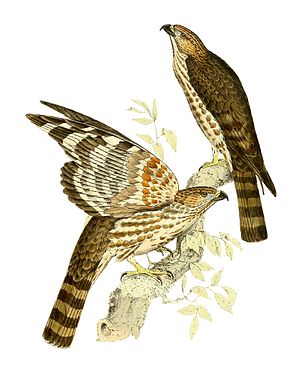Lemur consecration
| Lemur consecration | ||||||||||||
|---|---|---|---|---|---|---|---|---|---|---|---|---|

Lemur Weih ( Aviceda madagascariensis ) |
||||||||||||
| Systematics | ||||||||||||
|
||||||||||||
| Scientific name | ||||||||||||
| Aviceda madagascariensis | ||||||||||||
| ( A. Smith , 1834) |
The Lemurenweih ( Aviceda madagascariensis ) is a bird of prey from the genus of the crested buzzards ( Aviceda ). It is common on the coasts of the island of Madagascar .
features
The Lemurenweih reaches a length of 40 to 44 centimeters, a wingspan of 90 to 100 centimeters and a tail length of 20 to 23 centimeters. The adult birds are brown on top. The lighter head is streaked. The tail covers are piebald. The tail has three light gray-brown bands. The subterminal band is white. The throat is striped brown. The chest and flanks show a variable pattern of spots. The wax skin is dark gray. The large, protruding eyes are brown or dull yellow. The eye ring is gray-brown. Legs and feet are matt yellow-gray with a slight pink tinge. In flight, the plumage shows brownish, white marbled under wing-coverts. When seated, the lemur pond has a more buzzard-like habit. The underside is white. The flanks and chest band are reddish brown. The long wings are rounded at the ends. The juvenile birds look similar to the adult birds. With them, the top is darker brown, the head is more white striped and the white coloration on the tail base is more intense. The underside is drawn darker.
habitat
The lemur pond originally inhabited only primary forests , which included evergreen forests, semi-evergreen forests and swampy areas. Due to the destruction of the forest, he switched to the wooded savannah, meadows, degraded forests, secondary forests and dense bushland. It is also rarely seen in coconut plantations . It occurs at altitudes from sea level up to 1,800 meters.
Way of life
Despite the name, this bird of prey's main diet is not lemurs but chameleons, geckos, and larger insects, including grasshoppers. It is crepuscular and goes hunting individually. It waits for hidden waiting areas, flies with slow, powerful flaps of its wings, and then sometimes glides 70 to 90 meters on straight wings and beats its prey in the leaves or on tree trunks. Little is known about its breeding behavior. The breeding season is believed to be between October and December. A nest was discovered in the top of a tree at a height of 14 meters. The young birds are fed insects by both adults.
Existence and endangerment
There is no reliable data on the lemur consecration. Pessimistic estimates assume a population of 10,000 individuals or less. BirdLife International classifies it as “not endangered” (least concern), as its distribution area covers an area of 350,000 km². However, Madagascar is only forested to a third of its area and the area of the primary forests has shrunk to 10 percent. The lemur consecration is not common in the remaining forest areas. It has disappeared in the deforested central plateau and in parts of the dry south.
literature
- J. Ferguson-Lees, DA Christie: Raptors of the World. Christopher Helm, London 2001. ISBN 0-7136-8026-1
- J. Ferguson-Lees, DA Christie: The birds of prey of the world (German by Volker Dierschke and Jochen Dierschke). Franckh-Kosmos-Verlags-GmbH & Co. KG. Stuttgart, 2009. ISBN 978-3-440-11509-1
Web links
- Aviceda madagascariensis in the endangered Red List species the IUCN 2008. Posted by: BirdLife International, 2008. Accessed on March 1 of 2008.